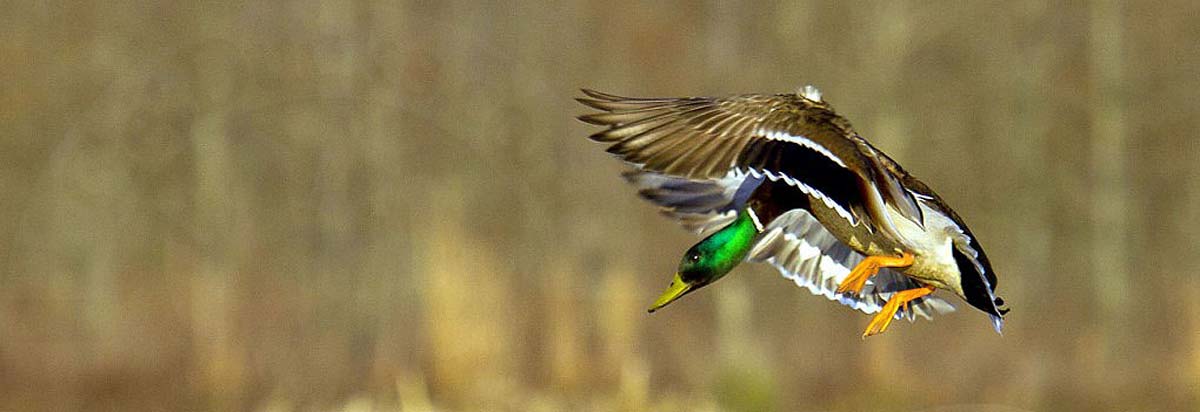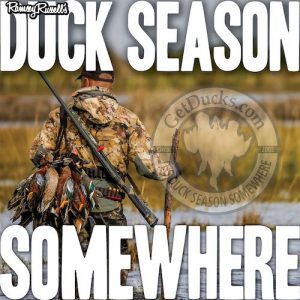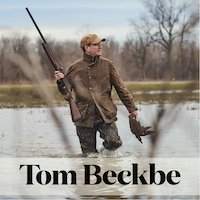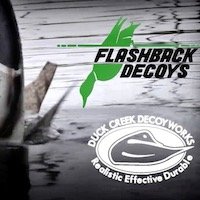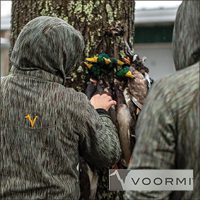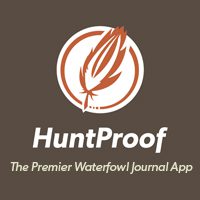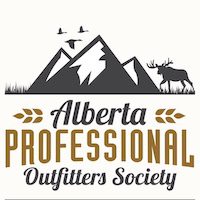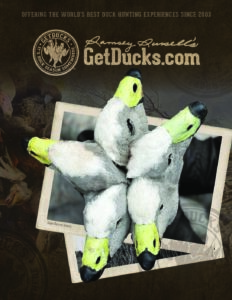We all know duck habitat when we see it, but what do ducks “see”–how do our beloved mallards experience and utilize habitats at the landscale level before, during and after hunting season? Could understanding this make us more productive hunters, better habitat managers and long-time conservationsists? Nick Masto (that’s Masto) is a duck hunter and recently completed his PhD at Tennessee Tech using the latest technologies. We do a deep dive into mallard habitat preferences on the wintering grounds and during fall/spring migrations, why they prefer these habitats, when they migrate, why they stop migrating, available forage on private versus public lands, hunting pressure influences, daily flight distances, the importance of early and late water on the landscape, sanctuary connectivity, landowner cooperatives and more. Whether a hunter, a waterfowl habitat manager, or both, you’ll likely appreciate seeing your hallowed stomping grounds through the eyes of wild mallards.
Ramsey Russell: Welcome back to MOJO’s Duck Season Somewhere podcast, where today we’re building on a topic of mallard migration, how mallards and why mallards come and when they come and what they do when they get to the south and what I’m beginning to realize is even if the midwinter waterfowl count is strong, we may not be seeing all the ducks in our backyards, something else may be going on. Just yesterday on social media, somebody posted up to me that, posted something along the lines of this elaborate complex of sanctuary from the prairie to the deep south and that all the birds are doing is hopping from one to the next and it’s by design, they believe. What do you all think about that? Joining me today to help me explain landscape and behavioral ecology of mallards, how mallards experience and utilize the North American landscape is Nick Masto. God dog it, Nick.
Nick Masto: You got it.
Ramsey Russell: I keep wanting to put an R in your name. Sorry about that.
Nick Masto: It’s all good, you got it. It’s Masto. Pleasure to be here, Ramsey. Thank you.
Ramsey Russell: No, Nick, tell me, let’s fly off into it this way, because you are a duck hunter and I love to talk to hook and bullet biologists. I don’t know how I feel about somebody doing science on waterfowl that is not themselves a duck hunter. I’ve always felt like most of the scientists and biologists I’ve ever met have a hook and bullet background. They were passionate of about hunting and about the conservation of this resource that they committed their lives to it at a pretty smart level, as guys like yourself tend to prove. What is your background?
Nick Masto: Yeah. So I grew up in the Upstate of South Carolina, so there wasn’t a ton of duck hunting opportunities, but my dad was a big fisherman and so my path kind of took a little ways where I at first thought I wanted to be a doctor or so. And then went to Clemson University and found some really great mentors and really got into it through dove hunting initially and kind of simultaneously with dove hunting and waterfowl research, and I knew I wanted to do wetlands research in general, became a duck hunter and really grateful to many of those mentors, both older and younger than I am. So really, towards the end of college, I got really into duck hunting and then took a PhD position out here in Tennessee. And boy, Tennesseans are really avid about their duck hunting and so I’ve really gotten into it here in the Mississippi Valley.
Mississippi Valley Duck Hunting Culture
Ramsey Russell: You better believe the Mississippi Valley has a duck hunting culture. I would say it rivals anything, heck, I would say that nothing else on earth rivals duck hunting culture in the deep south. There’s a lot of great duck hunting, a lot of great duck hunters and avid duck hunters, but it’s like a friend of mine in Utah explained one time and they’ve got just amazing duck hunting out there and a lot of great duck hunters a lot of close friends of mine out there great duck hunters. But he explained to me, we don’t have the culture that you all have in the deep south and he actually came down and hunted with some other friends of mine over at Beaver Dam, this lake and said it was just, it was everything he ever dreamed of just the food and the stories and the blinds and the habitat and the species. He said everything about it was just what I dreamed of coming to the deep south.
Nick Masto: That’s right. And I will say I moved to coastal South Carolina after college and got really into it and it’s very similar there, larger areas, blinds, breakfast. And so, yeah, the Southern United States really has just an unbelievable duck hunting culture and the landscapes really drew me to it, especially, you can be out there and shoot one blue winged teal in South Carolina, but this vast plantation and these huge impoundments were beautiful and same thing here in Tennessee, you get these cypress tubeless swamps or bottomland hardwoods and just these landscapes are absolutely gorgeous, too. And the culture and the camaraderie of duck hunting really is truly what drew me to it.
It’s the Mallard Every Time
And to me, if you understand mallard duck hunting, you understand duck hunting, period, because the mallards are what drive the whole system.
Ramsey Russell: I’m not surprised the topic of your dissertation was mallard ducks, because despite 30 something duck species in the United States, in North America, mallard is truly the rock star. That’s the duck, I mean, you think about it, Nick, the whole rule book of duck hunting was written for a mallard duck, the calls, the decoys everything about it. And to me, if you understand mallard duck hunting, you understand duck hunting, period, because the mallards are what drive the whole system. You know what I’m saying? I mean, I don’t, I can – Even to this day, I was fixing to say back in the day. No, just this day, we’ll go out hunting and on mallard days, I get my mallard limit and I’m done. I’m just not, less the birds are absolutely everywhere. I get my mallard limit, 4 mallards. Somebody says, well, how’d you do? Got a limit. That’s what I’m out there for and then there’s days that the mallards aren’t flying and we’re out there shooting the other species. It’s hard to break old habits like that.
Nick Masto: I mean, we love to shoot the green head. I think all of them are beautiful in their own right and love to chase gadwalls and teal and so on, but, yeah, mallard’s king and especially in the research world and GPS backpacks, especially, they can handle them really well as well. And we even base our harvest frameworks, oftentimes on mallard harvest rather than other species of ducks. They’re the rock star, as you say, both to hunters and to managers.
Ramsey Russell: Yeah.
Nick Masto: So we’re really focused on the mallard and for Tennessee in particular, where my research was conducted, shoot we wouldn’t do it on anything else, at least first.
Ramsey Russell: Right.
Nick Masto: You got it. We have the most mallards in Tennessee and so that’s what hunters are after and that’s what we need to be looking at, at least now. And now we’re just now diversifying into other species.
Filling Gaps in Our Knowledge About Ducks
Ramsey Russell: Your research is extensive, Nick. It’s very extensive, it’s got chapters and any one of them, I would guess, any chapter of your research could qualify for a PhD. Did it start off smaller and begin to scale as you started digging into this topic? And if so, how specifically did you start and how did it end up scaling?
Nick Masto: That’s a really good question. Just broadly, maybe I should back up and just say that I looked at the non breeding season ecology. So fall, migration, several chapters on winter and sanctuary use and habitat use and then even spring migration chapter, so just not breeding. And I think, I guess, to get to your question, it snowballed because I wanted to know everything about this duck and we had the opportunity to do so, deploying so many GPS transmitters. And so I wanted to fill as many gaps as possible in our understanding of the ecology of the species in general and how that might affect hunters and how that might affect land management and conservation planning and so on and so forth. It started as kind of a smaller, just focus on the winter, focus on sanctuary, focus on food and it turned into almost the full annual cycle of the mallard, other than the breeding ecology. So it just snowballed, Ramsey. When I put my mind to something, I do it all the way.
Ramsey Russell: I mean, so you started on the wintering grounds and started getting this information and I watched Cohen. I watched Cohen Waterfowl Labs on Instagram. I see all the maps you all are posting up and as you started tracking them back in the spring, you said, well, let me take it that level. Then when you started tracking them back down toward the wintering grounds, you’re like, well, let me take it, let me look into this, too. Did it almost spin out of control? How long did it take you to collect all this research?
Nick Masto: Well, I’ll tell you, Dr. Cohen and Jamie Feddersen and Dr. Hagy. Yeah, they said, man, it did spin out of control a little bit. But we got it all done, we got it all finished. It didn’t take me, I just put my head to the grindstone. It took me 4, 4 and a half years, which is pretty typical of a dissertation. Sometimes it takes people up to 6 years. So, yeah, it got out of control, I worked pretty hard. But when you’re doing something that you really love, understanding these birds and time flies.
Ramsey Russell: I tell my kids all the time, you’ve found your right calling when it’s work. Cause there’s no, I mean, there’s no w-o-r-k work, but it consumes you. You wouldn’t do anything else and it consumes you. And you hear your buddies talking about a 40 hours work week and you go, man, that’s rookie numbers. I’m 120 hours into it and I wouldn’t have it any other way.
Nick Masto: That’s right. And I tell my son that same thing.
Ramsey Russell: Nick, let’s start kind of in reverse order of your research. Let’s just take it from migration to the wintering ground and if we have time, back again, because I know that’s important, but talk about, we all know what migration is, it’s a phenomenon in the Northern Hemisphere that because of, generally because of winter weather and longstanding habits, these birds migrate from northern areas down to the south. Hopefully they migrate, sometimes they don’t, we found out this year. But what triggers them and what are their patterns looking like is these ducks are coming off the prairies and flying down to Arkansas, Louisiana, Mississippi, Tennessee, wherever they’re going. Let’s just start with that process.
Selecting Sanctuary
Within 3 hours of making landfall, waterfowl have already found sanctuary.
Nick Masto: Sure. So we did a little bit of research on that and then others have done very extensive research. I mean, the first thing that we found is cold days, it’s got to be cold. We found that there’s a lot of – You need to have snow and sleet preceding these areas. Just the same things that, for example, I think you had Mike Schumer on weather certainly triggers migration. One thing, though, that is really fascinating that we found is that these birds really needed some tailwinds or they really enjoyed to migrate on tailwinds and that was actually one of the strongest predictors of migration. So the way that we and barometric pressure. So, leading up to a storm. And so these birds both perceive the landscape as it is, I believe and so they’re responding to weather and they’re responding to temperatures, but they also say they’re also responding to things immediately. If they pick up and find a tailwind, they’re going to ride that thing and that was really one of the strongest predictors. One thing we didn’t find, which I think is just as important, there’s this hypothesis that as hunting seasons start to open, it causes enough disturbance and say a season opens in Michigan and it causes enough disturbance to push these birds down and we found no evidence that, that was actually the case. And then I guess I’ll just go on from there, we had that question of what initiates migration and which is what I just described. Well, we also kind of had a question, what terminates a migration, wherever it is? And so, one of the biggest things that was just mind blowing to me was within 3 locations after they had initiated a migration, what stops it? And we looked at it at 2 different spatial scales, a kind of a smaller scale and we’ll call it a landscape scale. It doesn’t necessarily matter for your listeners what those scales are, but the idea was the landscape scale is, hey, if I’m a duck and I’m looking down, why would I stop? And within 3 locations or 3 hours, these birds were selecting sanctuary and they were selecting areas with a lot of water, a lot of wetland availability.
Ramsey Russell: Within 3 hours of making landfall, waterfowl have already found sanctuary. Within 3 hours.
Nick Masto: Within 3 hours.
Ramsey Russell: Let me back up a little bit. You mentioned tailwind, which makes perfect sense. Obviously, cold weather and ice cover, snow cover, that’s going to help them. Hey, I got a tailwind, I’m going to fly easy. Barometric pressure, never heard that one before. I’m assuming that low barometric pressure, less resistance and they can fly more efficiently.
Nick Masto: Yeah. So it’s something that I think we’ve known in the bird literature for a long time. They have this innate ability to sense incoming storms, for example. And so barometric pressure, low barometric pressure relates to windy days, which makes a lot of sense for these tailwinds and kind of after a storm or something like that. And so, so the barometric pressure is probably just a cue of all of these weather events that get these birds to get up and go.
Migration Patterns: A Comparison Between Ducks and Geese
It rained about 500 mm, whatever that equates to in inches and we believe the ducks are going to be gone.
Ramsey Russell: What those birds can sense and detect never ceases to amaze me and I was talking to somebody on the phone the other day about back in 2018 or 19 or so, we were down in Australia, where there’s no continental migration and we were way down in Southern Australia province and having a great hunt, limit was 10 ducks daily. And I woke up and my hosts were whispering or huddled up over coffee, talking. And I said, what’s going on? They go, we’re going to go out and take a look around, but by 09:00 we’re going to be backpacked and hitting the road, we’re going north. I go, how far north? They go 500 miles or so. I go, why? They said, well, it rained last night. It rained about 500 mm, whatever that equates to in inches and we believe the ducks are going to be gone. I said, there is no way a duck knows that it rained inches 500 miles north of here and we went out that morning and did not see a duck and then we drove about 500 miles north into the Victoria province and we think we found lots of ducks. How those ducks knew that, how they can smell or sense some kind of weather change 500 miles away just blows my mind, a question I was going to ask you and then we’re going to get back onto this 3 hour phenomena you saw on the winter grounds. But I’ve heard of, like, white fronts coming off the Alaskan Arctic and being down in Louisiana on about 2 or 3 hops, hop, hop they’re down, maybe they fly from Alaska to the political boundary between Alberta and Saskatchewan, then they jump down into Indiana, then they jump down to Arkansas and then, bam, the next little hop. I mean, just bam. Very quickly 3 stops to hydrate and eat, boom, they’re where they’re going to spend the winter. What about ducks? What about these mallard ducks? If they leave Saskatchewan or leave the prairie or they leave wherever they’re coming from, how far they move along this migration, how many stops or what’s the progress? It seems a lot more gradual in the duck world than the goose world.
Nick Masto: Yeah. That’s also a really good question and this actually is not specifically in my dissertation, but we just presented a poster at the North American or not a poster, a presentation at the North American duck symposium and what we actually find, so, on average, in my dissertation what it shows, first of all, for context, is they’re stopping about 2 or 3 times for about 20 days. But those are real, those are averages across all the ducks that we had come back. But what we actually see is more of a – going back to this presentation, what we actually see is more of kind of a 3 part strategy where a certain portion of these birds get up and go and are in West Tennessee or the Bootheel, Missouri, in one long trip.
Ramsey Russell: The Halloween migrators.
Nick Masto: The Halloween ducks, exactly. And the middle or average ducks, if you will or kind of do what you described they’re gradually making it down, maybe they stop a little more often. And then we’ve got these cold ducks or they’re going to stay as far north as they can for as long as they possibly can, until that ice line, until that freeze line really makes them move.
Ramsey Russell: And I guess mallards have always been that way. I think so since the dawn of time. Maybe there were mallards that boom went on down to their wintering halts in October. Maybe there were some that got pushed a little further. Maybe it’s biologically designed to be that way, except during the grand passage years, those rare years that every duck in the north flies south for some reason.
Nick Masto: I think you’re absolutely correct. And these birds know to go to their ancestral wintering grounds and that’s just passed on through the generations and if you can think of migration as a bell shaped, curved right there, the average birds do one thing and on either end, you’ve got these slow and fast migrators. And so, yeah, I think they’ve always done that. I think that’s really their life history.
A Link Between Duck Genetics and Migration Patterns?
…we found a genetic linkage between those 3 migration strategies that I described.
Ramsey Russell: It makes me wonder. It almost makes me wonder if you break out the North American matters into 3 migratory subsets or migratory cohorts, it almost makes me wonder, is it genetic or is it physiological? I mean, what I give me something to think about while I’m waiting on ducks to show up.
Nick Masto: I will say and again, I want to caveat this, that this was a presentation that we gave and so this isn’t published and this is actually not in my dissertation, but we’re working with Phil Lavretsky and others and we did what’s called a genome wide association and we found a genetic linkage between those 3 migration strategies that I described. So it’s suggestive evidence that perhaps, well, it’s suggestive evidence that it is genetically ingrained and that maybe the number or the migration strategies could be changing. But again, that’s not exactly my dissertation. One thing that we did find in terms of the fall migration that is pretty astounding, is that these early migrators, but really all of these birds came back to the air, to the general area, Western Tennessee or farther north. So we had very few, I think we had 2 or 3 birds that came back down past, essentially stuck guard. We didn’t have any go to Louisiana, for example.
Ramsey Russell: Well, we’ve heard from other people and we’ve gained a sense of understanding that ducks have high fidelity for certain areas, that they’re not just generally just migrating south willy nilly. Somehow or other, they got a great idea of where they’re going, they know where they’re going. How specific is that fidelity in your research? I mean, when these ducts are coming down, you say the general area. How general or how specific are they coming to?
Nick Masto: Yeah. So we had, let’s see. I’ll give you a few percentages off the top of my head. So, 38%, I think we had about 90 – So let me backtrack a little in saying that we’re deploying these transmitters in the winter. So we deploy 500 transmitters. Well, we get in the fall migration about 100 back or so and so we had, it’s a little less than 100. I think it was about 90 birds. But the ducks that returned, we had 38% of birds returned to Tennessee and another 37%. So about 70% total return to the area and when I say the area, I mean within 80 miles. So I’m talking Bootheel, Missouri, Western Kentucky, Northeastern Arkansas, Southern Illinois, Tennessee.
Ramsey Russell: Yeah.
Nick Masto: Yeah.
Ramsey Russell: So those are, if I’m a local hunter in one of those areas you just described, for example, those are my ducks. They’re coming to my place. They’re not just passing through or those are my ducks.
Nick Masto: That’s exactly right and what we initially deployed 500 transmitters during the winter because we expected a lot of those ducks to migrate. We would catch them in November, for example and we expected many of them to leave. We thought they’d go to the Mississippi Delta. We thought they’d go down to Stuttgart or we thought they’d go to Louisiana and turns out that wasn’t the case at all and it’s something – It’s very simple statistics to tell our stakeholders in Tennessee that those ducks in Tennessee are your ducks.
Ramsey Russell: Yeah.
Nick Masto: Something really has to push them down. And so far, in the 5 or 6 years since I’ve been here, we haven’t really had any sort of weather that they could push them down.
Protecting Fall Waterfowl Migration
The goal isn’t to hold the ducks, it’s to have them have these safe areas so that they can then radiate out when they stop and make themselves available to hunters or increasingly bird watchers, for example, depending on where you are.
Ramsey Russell: Right. There seems to be a persistent or prevailing perception that ducks migrating, mallard ducks migrating south are literally hop skipping and jumping from one sanctuary to the next. Were you able to see that in your studies or is that just a myth?
Nick Masto: For fall migration, they very much clearly are using sanctuaries as migratory pathways. I’ll say that, that is one reason why, for example, the national – That is a goal of the National Wildlife Refuge System is to provide these safe areas down the flyway. The goal isn’t to hold the ducks, it’s to have them have these safe areas so that they can then radiate out when they stop and make themselves available to hunters or increasingly bird watchers, for example, depending on where you are. And so, yeah, ducks are using, if they’re making 3 stops, what we saw in our fall migration is they’re stopping and using basically one sanctuary and radiating out within a certain distance outwards from those sanctuaries. Now, when they get to Tennessee – Go ahead.
Ramsey Russell: No, go ahead.
Nick Masto: No, when they get to Tennessee. I don’t want to make it sound like ducks are only using sanctuary. Because they clearly, no matter what, they are radiating out from these sanctuaries. So the goal of these sanctuaries, no matter where you are, is not to hold them. It’s really to hold them in the area, to make them more regionally available to the hunters in that region, wherever you might be. And so –
Ramsey Russell: During your research, to your point, we’re talking about sanctuary, we’re talking about safe areas, but by necessity, they don’t get shot at on those areas, but by necessity they have to radiate out, because one of the charts of something you sent me is, in West Tennessee, 72% of duck use days of the nutrition, the kilo calories on the landscape, 72% are on private land. Oh, they got, they’re going to starve to death if they stick on the sanctuaries full time.
Nick Masto: Yeah, that’s absolutely right and what we see in mine and in Cory Highway’s research is that these areas, they hold a lot of ducks but the food depletes on these areas and so you’re absolutely right. They got to move out and in Tennessee, we have a lot of food on private lands and so 72% is exactly right. And so these birds really do have to leave the sanctuary now, it brings in another important component of my research is that hunting pressure, which we were actually able to measure across a really vast landscape. The hunting pressure can kind of force this nocturnal type movements. And so my guess is that a duck would maybe prefer to feed during the day. But if it can figure out a pattern of staying on sanctuary, regardless of whether the sanctuary has food and then just go to a private land, a cornfield, for example, and eat at night and establish this really consistent pattern, well, that’s how you survive and what we actually found is, gosh, 71% of our individuals flew off a sanctuary. Their flights were less than one and a half miles, which means that, which indicates to me that there’s enough food just right around that area to sustain these birds throughout the winter.
Where Did All the Mallards Go?
Where in the heck are the mallard ducks disappearing? The hen mallard ducks disappearing?
Ramsey Russell: You talk about hunting pressure and I’ll argue with anybody. Tell me one problem perceived in modern duck hunting today, one. Tell me one problem and I’ll argue tooth and nail has to do with habitat loss. Whether we’re talking crowded boat ramps or environmental climate change I’ll argue habitat loss. I heard recently somebody say, well, Dr. Osborne say he bands one hen per 5 Drake mallards during the spring season and he recovers one hen mallard per 15 Drake bands in the fall. Where in the heck are the mallard ducks disappearing? The hen mallard ducks disappearing? I’ll argue habitat loss. We’ve been on restrictive bag limits of pintails for 30 years and still pintails are imperiled because of habitat loss. And 30 years ago, I’m guessing now, shoot what Dr. Afton down at LSU had demonstrated that a lot of blue bills and pintails were rafting way offshore in the Gulf of Mexico during the day rather than spend their time mainland getting shot at. And now, 30 years later, you’re starting to see with 500 GPS birds, you’re seeing some of the same trends. You’re able to really get to a fine grain of what this hunting pressure and how these ducks are responding to it.
Fragmentation of the Landscape and Its Effects on Wildlife
Well, I don’t think that we’re in a shrinking and fragmented landscape, and so where there’s water, there are hunters and so that really drives the behavior of these birds.
Nick Masto: Yeah, that’s right. So there’s a lot there to unpack, but 30 years ago, Dr. Afton was seeing that getting away from hunting pressure and like you say, I’ll argue with anyone. We have onyx, we have mud motors, we clear places that were formerly natural sanctuary, not sanctuary that a duck could just get to because they could get away from people. Well, I don’t think that we’re in a shrinking and fragmented landscape, and so where there’s water, there are hunters and so that really drives the behavior of these birds. And these birds perceive that these birds get it and if they don’t, if they’re new ducks, for example and they don’t get it and they bounce around these refuges, they will be harvested. They have much higher probability or much higher likelihood to get harvested. So, for me and for a lot of our research we’ve demonstrated some of the importance of sanctuary, not just to the ducks, but for hunters. And if I may go, it seems to me very much so that we probably need more of it, not less.
Ramsey Russell: Yeah, I’d agree. So let’s get into, back into the wintering grounds, we’re talking about sanctuaries. How do mallards experience and utilize their wintering landscape?
Nick Masto: Yeah. So what they do is when they get here, they find a sanctuary.
Ramsey Russell: Do you see it as the same sanctuary or complex of sanctuary year in, year out? Like those mallard ducks, you say they’re very specific to where they’re coming, are they coming to the same refuge every year, same sanctuary?
Nick Masto: Oftentimes, that is the case. So, in our fidelity research we had 25% of ducks actually return to the same exact place they were, which is pretty amazing to me. But ultimately, it doesn’t really matter, because when we catch them on sanctuary, that’s where they stay. So the way in which they perceive their landscape is that everything other than sanctuary is safe or excuse me, is risky. And so they’ll stay tight to one sanctuary throughout the entire winter. So, just to give you some numbers here we have birds that stay on one sanctuary. Well, the birds that we have captured across about 450 individuals stay on one sanctuary, 69% of them stay on one sanctuary the entire winter.
Ramsey Russell: Wow.
Nick Masto: And so if that, we put that in a model and sophisticated complicated analyses, it doesn’t really matter, but what that really translates to is that a duck, if we catch it in November 1, it won’t use another sanctuary until it’s in our study area for 80 days.
Ramsey Russell: And why would it change? Just because of, it fed out or water conditions or –
Nick Masto: Yeah, it would change maybe just because of the other ducks that maybe use 2 or 3, right. And so that’s basically, it would change because, for example, there’s no more food because it got lost, like, it could just switch a sanctuary, I mean, that happens. But the bottom line is, one goal of these sanctuaries, especially the state sanctuaries, but also the federal national wildlife refuges, is to disperse these birds across the landscape and hopefully have them trade sanctuaries. And so you can imagine if they’re doing that during the day, then hunters might see more ducks, they might have more opportunity to harvest more ducks. But what we find is, even in our area, because the hunting pressure is so intense, I believe they just want to stick tight to sanctuary and so 70% of ducks staying on one sanctuary is not necessarily the goal of what these sanctuaries are for, which is kind of what I was getting to when I’m thinking out loud about, how do we implement more sanctuary? What are the best sizes and distances? I guess, if I may, what we found is that proximity to sanctuary drove sanctuary connectivity or movements from one sanctuary to another, it didn’t really matter the size. As long as they were close to one another, as long as you had a safe area close to one another, then these birds could hop and skip, if you will.
Ramsey Russell: Yeah.
Nick Masto: And potentially make them more available to hunters. More available, well, definitely not to hunters in our area, but in other areas, maybe more available to bird watchers or so on and so really –
Ramsey Russell: Ethan Dittmer was on here previously. Are all sanctuaries created equal? And we got a little bit into this subject and he believed that a good balancing act of, we need sanctuary, but we want the ducks to move a little bit instead of becoming habituated to big tracks. He proposed, as I understood it, a series of smaller and more little micro sanctuaries where these birds would have to or would just necessarily trade around more.
Nick Masto: That’s right. And maybe I’ll give a little background and then I’ll just tell you, so a little background of that is you can put – So what we found is, for example, if a sanctuary, 2 sanctuaries were 13 miles apart, then a bird, a duck, would had, like, maybe what was it had less than a 50% chance to switch. Okay, but if you had, for example, a sanctuary 6 miles apart of the same size, that would increase that chance to 88% and it would increase connectivity threefold and so on and so forth. If you had it at 3 miles apart, that would increase connectivity sevenfold and it really has to, it goes back to these flight distances and these birds are not moving very far and so we think and we believe that more sanctuary is important in these high risk environments especially. And the more a duck trades sanctuary, the more that they’ll have to relearn that new environment and potentially the more susceptible to harvest they are. And so we think that more sanctuaries for waterfowl basically, regardless of size, although that probably needs to be researched more. More sanctuaries might degrade that map, that spatial map that they have in their head and degrade these patterns of back and forth nocturnal movements and benefit hunters and so with that, I’ll just plug that the Tennessee Wildlife Resources Agency is actually doing this research. So they are, the PhD student on that project is Cory Highway and under Dr. Bradley Cohen’s supervision and the TWRA are leasing public lands closer to other mainland sanctuaries, if you will larger sanctuaries, to better connect the river bottoms in Western Tennessee and the general hope is that it will improve duck distributions. It will prove hunting and by all accounts, what Cory tells me and what we see and what I talk to some people, it seems to be, a, very well received and b, people are thinking they’re having better hunting seasons and so when Cory kind of comes out with some of his research, you should definitely get him on here to tell you about it. Yeah.
Ramsey Russell: Absolutely. You all put all those transmitters on these mallards. Did it matter? Did age ratio matter? And here’s what I’m getting at and dumb question, but it hadn’t stopped me before, a big old white-tailed buck, one of them old mossy backs, man, they’re a lot harder, they make fewer mistakes, they go nocturnal, they stick to their patterns. They’re harder to hem up than a young up and comer buck. Can you see the same thing in mallard? If you’ve got 70% of your mallard study group coming down to specific refuges, are the younger birds that are less practiced? I mean, do you have some 5 and 6 and 7 year old, some older mallards that don’t mess up? Do they come back and stick to the script? Do they remember the script, year to year versus a young duck that forgets?
Nick Masto: We thought they might and we also thought, for example, drakes would slip up more, given that you mentioned, I think, earlier, the 3 to 1, 4 to 1 ratio. And you got to remember that mallards are early pair bonders, so they’re in search of potentially limited females. No, in short, it did not matter. These birds learned quickly and it didn’t matter whether you were a juvenile or a male. If you had a pattern, you’d try and stick to it best you could. And I think you have to think that these birds have been shot now from Canada all the way to Tennessee.
Ramsey Russell: Since September 1st.
Nick Masto: That’s right and so they figure the script out and by the time they’re in Tennessee, they’re not, just because they’re juveniles doesn’t mean that they haven’t figured it out. I mean, they may be more likely to slip up, but our research does not suggest that at all, which I think probably just speaks to how fast they have to grow up.
Duck Hunting is a Perilous Sport
Ramsey Russell: Oh, yeah. A famous newscaster named Walter Cronkite once said that duck hunting is a perilous sport, especially for ducks and a lot of truth to that. So what other factors, like this year, we’re coming out of a drought, bad drought and I read somewhere along the way that these waterfowl have fidelity for certain spaces, quote, despite geographic or landscape differences. Does that say that these mallard ducks are going to at least come down to Tennessee, Arkansas, Louisiana, wherever this study group was and take a look at conditions before they spread out, I mean or they just, they’re going to come to this area regardless and if there’s no water, then they’ll fly somewhere else? Is that what you’re saying?
Nick Masto: That’s basically what our research shows, is that, for example, in West Tennessee, which I can speak to directly, we just published a paper about this. And what these birds were doing is even during the pre-season, when they’re not being hunted or anything like that, they’re selecting these sanctuaries. Now, you can imagine, especially this year, but even, gosh, I guess in many years, we don’t typically have a ton of water on the landscape in the early season. The places that have all of that water are these waterfowl sanctuaries. They make sure they have that water for the birds that come down here and places on, for example, private lands and even some, what I’ll call state quota hunted areas. They’ll want to save a little money, they’ll want to wait till the rivers get overbanked full, they’ll want to wait for the precipitation. But these sanctuaries really pump and they have the infrastructure to pump as best they can. And so, yeah, I think water especially was so important and consistent water year in and year out could make a huge difference in my opinion, on how faithful that duck is to a region. So, for example, in our area, we’ve got 13 or 14 sanctuaries, all of which have water, many or most of which have food and we see a very high pattern of fidelity.
Ramsey Russell: Well, it’s not just that the managers are loyal to putting water on the landscape in a timely manner, but to keep the water after the duck season. Do you believe that waterfowl use that to imprint? I mean, for example, I can think of a camp I know all too well right now, Mississippi, that is chomping at the bits to pull the water off a day after duck season and I watch my buddy, the late Ian Munn, go tooth and nail with the powers that be over holding water. But there really is a lot of truth, a lot of practical truth to holding the water on the property lake into the spring so that these birds can come out of hiding, imprint, make a living and then fly back north and they’ll remember that and come back to you the following year.
Nick Masto: Yeah, that’s a great point and I’ll just caveat that we don’t know a lot about imprinting scientifically, but it is my personal belief that, for example, in the Mississippi, alluvial valley. That preseason water is really important.
Ramsey Russell: How preseason? Because that’s another point, I’ve had Heath Hagy on here before, we’ve had other biologists on here before. We talk about the benefits of early water on the landscape because it just, boom, it’s like miracle grow on the invertebrate population. If you’ve got a pothole out here that’s holding water in the summer, then when that whole impoundment flood, boom, it just spawns. It’s just so much more productive than to a duck than water that we just pumped up 2 weeks before the season, early water. So, if I were a manager trying to apply what I’m learning in this podcast here, it would behoove me to put water on when the blue wings start coming down or even early in the season, start flooding up these impoundments to start catching and attracting ducks.
Nick Masto: Yeah, and it’s context dependent. And so in the MAV, in Western Tennessee I would certainly encourage managers to put water on as early as they possibly can to and as early as they can afford to. I mean, that’s a big consideration and we all know that. In South Carolina, coastal South Carolina, I flew aerial surveys for my masters and during the late season, water was actually really limiting because as soon as managers or as soon as the hunting season came out, managers pulled the plug on their impoundments, these really large historic rice fields. And so sanctuary there was important to provide that water that these birds need and supplemental food to make it back and send these birds back up to the breeding grounds and on spring migration, fatter and happier. And so I think it’s very context dependent. It’s not one size fits all in Western Tennessee, I think water is extremely important in the preseason. I think that the amount of food that we have in the late season allows them to beef up before migration so I think both in combination are important and I think maybe that has something to do with this phenomenon, this imprinting phenomenon, which we, of course, don’t know a ton about, but is important.
Ramsey Russell: Did your research on the winning ground? Did you see some of the same behavioral patterns with regards to mallards using private land where all that food is? Did you see the same patterns that Ethan Dittmer did, that they’re given a choice? They’re hitting that feed at night increasingly and does it progress as the season gets longer?
Nick Masto: Yeah, we largely found exactly the same results as Ethan and in terms of how these birds are perceiving the landscape, they perceive and pick up on risk and we even did a study, we didn’t do it. So they designed their study, very interestingly, where they had inviolate sanctuary, which I actually didn’t know until he told me. But those could be, they couldn’t be duck hunted, but they could be people could be on them. There’s some sort of recreation. But what we did is we just categorized it as spatial sanctuary, temporal sanctuary, which was quota hunted areas. So areas that were rested 3 days out of the week, hunted 4 days out of the week and then we just categorized the larger group into human access, which was primarily private lands. And there was 1 or 2 WMA’s that you could theoretically hunt every day of the week.
Ramsey Russell: So in the context of sanctuary, yours could be sanctuary, in the context of your research, could be described as prohibited access to humans. That’s just –
Nick Masto: That’s right.
Ramsey Russell: Unless it was temporal and then it was accessed by humans, but only a few mornings a week.
Managed Moist Soil Resources and Cornfields to Hold Waterfowl
Ducks selected night time high energy food resources, so managed moist soil resources and cornfields at night on private lands and on limited access or temporal sanctuary.
Nick Masto: So, I would largely just consider it, if you will, private lands, which we don’t really – Well, we know now and I can talk about that a little bit, if you’d like. But what we did was we categorized it essentially as private lands, which those are notoriously hard to understand, how private managers are actually managing their sanctuary, if they have any which, again, we found that they didn’t, but I’ll tell you how we found that out later. But then we had temporal sanctuary, which we considered those quota haunted areas, those specific state properties that allowed 4 days of hunting and 3 days of rest and then spatial sanctuary, no human access during the hunting season and what we found, again, is largely the exact same as Ethan’s project, that preseason water was pretty darn important. Ducks selected night time high energy food resources, so managed moist soil resources and cornfields at night on private lands and on limited access or temporal sanctuary. And the temporal sanctuary, in terms of 3 days to a duck, is not sanctuary at all. And there’s been really a lot of literature now to kind of support those findings that temporal sanctuary to a duck is probably measured or I guess sanctuary in general is probably measured in weeks. It’s not 3 days. And you can’t give it one day of rest and then hunt it again and then give it another day of rest.
Ramsey Russell: It’s almost the opposite of that. It’s almost like, if I want productive duck hunting on a heavily hunted private land. Maybe I should just shoot it on Saturdays and let the ducks have it the rest of the year or the rest of the week.
Nick Masto: That’s probably right, in many places and I think there was a study I mean, even Saturday and Sunday twice a week, you might have more productive funding. But I would say largely sanctuary needs to be undisturbed for longer than what we originally thought. 3 days is probably not enough.
Ramsey Russell: Well, I’m remembered, again a conversation with Heath Hagy telling me about a research project that on sanctuary, the doctor sitting out there on a Fish & Wildlife impoundment or whatever, had been there forever. And I think they drove a boat or drove a bike or drove something out right through the middle of them just to see what they would do and he said, oh, they came back. But for 3 days they didn’t hardly blink their eyes. It’s like they’ve been broken into, I don’t know if you ever walked into a house that’s been broken into, you don’t sleep well at night for a while. He said they had been violated. They literally landed back on that impoundment and didn’t budge for 3 days. And so much so that the adjacent landowner said, what in the heck happened? We haven’t seen a duck fly in a week. I mean, man, that’s crazy, isn’t it?
Nick Masto: That’s powerful. That’s part of Abby Blake Bradshaw’s research, who we conducted our research simultaneously together. She did this experimental disturbance on these sanctuaries because the idea was, okay, the initial idea was, okay, well, let’s see if we can’t get these birds up and move them around a little bit and hopefully that would be kind of a dual success if, for example, it increased haunting opportunity and maybe showed the state agency, hey, we can allow a little bit of access on these areas. But what she largely found was that it decreased hunting opportunity and I won’t steal her thunder here, but you should definitely get her on, too. She just graduated, same exact time as I did.
Ramsey Russell: I’ve got her on my list.
Nick Masto: You got her? There you go.
Ramsey Russell: I got her on my list. Yeah.
Nick Masto: Yeah. So I won’t take that away. But largely, I guess, what we see is how important these areas are. And if I can just come back to these this patchwork of smaller areas, for the longest time, we’ve been buying sanctuaries that are really large. But it doesn’t appear as though size matters in terms of these ducks traversing the landscape. It’s really, can I get to it in a short distance? And so if we can put more of these on the landscape in this heavily hunted system maybe they’re more harvestable.
What Do Ducks Look for in a Sanctuary?
Within the sanctuaries, was there preference for any form of cover or vertical structure over another or was it strictly the absence of shooting pressure?
Ramsey Russell: Within the sanctuaries, was there preference for any form of cover or vertical structure over another or was it strictly the absence of shooting pressure? What I’m trying to build here is, we’ve established several times with yourself, with Ethan Dittmer and Heath Hagy and a lot of others, about the effect of hunting pressure. And so now, what I’m sitting here trying to figure out is, as a private landowner, if I want to create habitat conditions and I want to remove my presence or minimize my presence on the landscape, to try to invite ducks in more frequently. But is there a preference? Is there anything I can do on my private land besides not hunt it, to entice ducks to come and lay up on me?
Nick Masto: How much land you got?
Ramsey Russell: That’s a good, we’ll talk about that, too. I don’t have enough.
Nick Masto: So a lot of these sanctuaries do have, at least the ones in our area and you could contrast this a little bit with Ethan’s work, which I believe was primarily bottomland hardwoods, something like that. A lot of ours are managed impoundments, moist soil impoundments, cornfields, there’s woody wetlands and so lots of these areas have a bunch of different characteristics about them. And what my habitat selection study showed is, on sanctuary, they’re just selecting it all. It doesn’t matter because it’s safe and so the bottom line, I think, I don’t know what sanctuary is better than the other, because certainly we did have, for example, certainly we had sanctuaries, maybe with no woods or something like that or conversely, bean switch refuge, all woods. But largely what the research suggests is that it doesn’t really matter what’s on there. They’re just selecting it because they’re selecting all of those land cover types because it’s safe.
Ramsey Russell: Yeah.
Nick Masto: That, I think, is the take home message.
Ramsey Russell: Well, is it a simple equation on private lands that the lands selecting is because they got food and I’m born, here’s where I’m getting at it is like years ago, fooling around on moist soil management. The coffee weed would kill us and we’d have so much coffee weed out there, we didn’t know what to do with that the, ducks could land anywhere. Oh, we figured out how to get rid of it. Well, we cleared all the impoundments of coffee weed and by God, the duck could land anywhere and what we found is, whether we misappropriate the word hemi-marsh or not, what we found or what we felt like we found, in terms of effective hunting and having habitat that offered the ducks something different, was to have 40%, 50%, 60% vertical structure out there, whether it was button bushes or coffee weeds or some other kind of crop or relative to the just open water. And so I’m just sitting here thinking out loud, did you see anything? A preference on private lands or sanctuary, either one. So now we’re talking about private lands for some form of vertical structure and covered it. Many years ago, when I was a young guy hunting the Mississippi River hunting between the levees, those ducks had just mile long stretches of riverbank and sandbars and everything else they could stand on without getting shot at. But when you found the flooded cockle burs, that’s where you were going to get them, because they would land and we would, the dog would fetch up mallards and have to spit out cockle burs, they were landing in it. They’d get them cockle burs all up in the feathers. But they love to be up in that cover.
Nick Masto: Yeah. So when we’re talking about private lands, it’s typically you have less area. But if you can and I think what you’re really asking is what makes the best sanctuary? If I have a certain number of impoundments and that’s probably, it’s a difficult question to answer, but I’ll do my best, is that vertical structure you talked about, I’m glad you brought up coffee weed. People think that it’s the worst plant in the world, but if you have a really good moist soil unit out there that has 60% coffee weed or 50% coffee weed, as long as it doesn’t shade out those moist soil plants below, that’s probably a pretty darn good sanctuary because these birds certainly do like vertical cover. Likewise, if you don’t want to hunt a flooded cornfield, for example, maybe you could set aside, because what they clearly are doing in a high pressured environment is what they clearly are doing is foraging at night. Well, you don’t want to plant corn on your area and then just eat your corn out. At nighttime when you’re not going to be able to hunt it, maybe your sanctuary has some corn and moist soil mixed in there, which corn provides vertical structure and so if you’re going to plant, that might be the good sanctuary and then you hunt the nice marsh, emergent marsh area if you find a good hide there. And so the idea is to juxtapose it as best you can. But the big key takeaway is that, yeah, the sanctuary has to have no disturbance if you’re going to implement it.
Ramsey Russell: And you’re talking about a lot of your ducks in your study area. We’re just flying an average of a half a mile, a quarter mile to a half mile, to a mile and a half. Okay, so I’ve got a property and I’m being rhetorical here, the listener has a property or hunter property, a lease, whatever.
Nick Masto: Yeah.
Ramsey Russell: How important, how am I trying to word this? What are we talking about in term of landscape? In terms of a radius around that property? I’ve got, maybe I’ve got a crop I’ve got soybeans. I’ve got rice, I’ve got corn, I’ve got moist soil, I’ve got timber. How important is that? In what area should I take into account my surrounding landscape?
Nick Masto: Yeah. For a private landowner, I would think I mean, for when we’re using the flight distances of our ducks that are captured on sanctuaries, we’re talking half a mile to 3 miles. And there’s clear disturbance buffers, if you will and so, for private landowner, what I would probably, I guess what I would suggest is that if you can take into account a 3 mile radius, that would probably be really important and it’s important to know what adjacent properties are doing. If an adjacent property, all they’re doing is corn, you might want to do something different because the birds might be roosting at night on that cornfield. It kind of brings me a little bit to, what I did want to talk about with you is that through our connectivity research – So lots of private lands are not big enough to support a sanctuary. It’s just as simple as that. I mean, people are paying a lot of money to lease these lands and so what we proposed in one of our manuscripts and dissertation manuscripts in review. But what we proposed is what if, so I mentioned that the TWRA, who primarily funds all of this research is leasing some private lands. But what if we got these private landowners, adjacent private landowners to share resources a little bit. I can pump, you can pump, you can pump, I mean, I’ll plant this, we’ll do this. But let’s establish one of these small refuges or stepping stone sanctuaries, between these 2 larger sanctuaries. And what we’ve been calling them is private land, waterfowl management cooperatives, if you will. It’s just a name we made up, so we’re going to work with that, we don’t know what it is, but it seems like it could be a pretty good idea. QDMA, Quality Deer Management Association has been doing that for a long time and has had great success. I mean, the primary amount of land in the southern US is privately owned. And QDMA has said, okay, well you’d be getting in fights with your neighbors about who’s killing my buck, that’s my buck. Well, QDMA said, well, why don’t you adjoin your properties and you combine your fiscal resources. Because these birds, just like those deer, don’t understand jurisdictional boundaries and so they had great success with raising healthier deer herds and having better recreational opportunities. And so it just provides, I think, another mechanism other than the state leasing lands, which is probably going to be pretty expensive in the long run. What if you talk to your neighbor, especially if you don’t own a very large property and say here’s how we’re going to try and do it. Let’s make, this is my property and I have a refuge, I’ll put this area in refuge that’s kind of near your property and then you put that the water that you can pump in refuge kind of close to that and we can kind of combine our resources and create these stepping stone sanctuaries in between these larger ones, the state established ones, the National Wildlife Refuge ones.
Ramsey Russell: One plus one equals 3. In a fractionalized landscape, one plus one equals 3.
Nick Masto: Exactly.
What Attracts Migrating Ducks?
Ramsey Russell: And it seems like I’ve started hearing organizations, I think, up in Missouri start talking about, I think there’s an organization up in that part of the world, Osage, that is starting to advocate landowner cooperatives like that, just working together for the benefit of the waterfowl. And I think, as you’re saying that I remember we worked with an outfitter up in Southeast Wyoming, WyoBraska, that all things equal has ducks and geese, especially from the beginning to the end. But for as long as anybody can remember, there is a handshake landowner type cooperative that encompasses 7 miles of North Platte River.
Nick Masto: That’s unbelievable.
Ramsey Russell: And after a certain date, it is a complete inviolate sanctuary for the purpose of holding ducks and geese. Just these landowners saying, all right, you can shoot it up for a couple of weeks of season, but after that, all bets are off. You can hunt somewhere else and you cross the bridge and look both sides down the river and it’s just black with geese and ducks when you start thinking about that is one way that we duck hunters and landowners and leaseholders can work together in a shrinking landscape for the benefit of all. It goes back, you were talking about, what do ducks say? You started off talking earlier this morning about a duck flying at 30,000ft and looking down what attract them to that area. And it’s like, the more that landscape, I’m just imagining it, I’m a duck flying and the more of my view that I see as habitat, the more me and my kind are going to be attracted into this area. We see a lot in the Mississippi Delta, for example, when you start looking at mid winter waterfowl counts, it’s a real clumped distribution now compared to what it was 20 years ago. It’s a very clumped distribution of waterfowl throughout the Mississippi Delta. And those ducks are clumped in geographies that have more relative landscape committed to waterfowl habitat than the remainder of the delta.
Nick Masto: Exactly. I don’t think I could have put it any better and I’m glad and I think it’s really great what you do, Ramsey, is translating some of this science into the public, because what we really probably need to do is communicate how important these refuges are to the general public and start this conversation of landowners working together to have refuge. And I think ultimately, it’s going to be for the good of the hunter, which is a really scary thing because we’re losing hunters, a lot of them. And so the better quality hunts are the ones that, for example, I remember, now the state agencies have to provide for quantity hunting opportunities. But I remember the quality hunting opportunities and private landowners are probably going to be the ones that provide those quality opportunities and so if we can spread out these birds a little bit by having smaller sanctuaries that are connected to one another, having private landowners work together to establish some of these smaller sanctuaries, potentially, I think we’re going to do a good job in terms of providing the needed habitat for these birds and also providing quality hunting opportunities.
Ramsey Russell: Nick, do you know the only thing worse than not killing ducks in the morning, if you’re a duck hunter, there’s one thing worse than not shooting ducks in the morning and that’s hearing somebody else volley, that’s like sitting bored shitless in your apartment or your room watching reruns of dancing with wolves or something you’ve seen a 1000 times while there is a party going on next door and you ain’t invited. It is the worst feeling on, God, so you got to give us duck hunters got to have a break now. I mean, cause now we got to work together and if we work together, my neighbor, I might be listening to him shoot more ducks and me and that’s a hard thing for a duck hunter to get over, man.
Nick Masto: That’s right. And if you were buddies with him, then maybe you could rest your property, for example, if we go back to temporal sanctuary, maybe you could rest your property for a week or 2 and you all hunt his property or her property and switch maybe, it’s all about working together for these quality hunts and it’s probably really important to take young people with you, too.
Ramsey Russell: I asked old Terry Denmon. He and I were hunting up in Wyoming this year and it was 650 the week before Christmas and there were lots of mallards. We would see them come off the sanctuary and come to the feeding areas, oh, about 5 or 10 minutes after shooting time. And that is a very humbling feeling when you have sat in a blind all day long, knowing there are tens of thousands of mallards around and ain’t nothing coming in the decoy, but you got to do it. And I asked old Denmon, I said, Denmon, think about this, you’ve been hunting for what, 50, 60 years? I’ve been at it for 40 years and if I added up all the minutes that I was in a blind waiting on a duck, not shooting, not pulling the trigger, it’d be 99.99% of the time ever spent duck hunting. I’m waiting on a duck to fly, not shooting and it’s very important to do that. And I guess I’m saying that to lead up to, at some point in time with the shrinking landscape with the water issues, with the habitat, with all the ailments, the symptoms that are pursuant to that condition, to a shrinking landscape we’re becoming more highly distilled into fewer areas. It’s becoming manifest in a lot of different ways, none of it good for hunting. At some point in time, I kind of got to ask myself, as I get older, I think everybody listening and everybody, every duck hunter in America’s kind of sort of got to ask himself, at what point do we choose a quality experience? And I don’t mean just going out with my buddies and having a good time and whatever, I’m talking about the trigger pulling part, because none of us are out there to watch the sun rise. At what point in time are we going to choose quality time of field versus quantity time of field and that’s really and truly where we’re coming to sooner than later. We’re sitting here talking about, I’m a member of a camp that has, we have zones, so we’re not going to hunt, we’re going to hunt this area 3 times a week, let it be for 4 days. Move around, move around. Now, we still have deer hunters trafficking around, we still have traffic going around. So it’s not just because we’re not there duck hunting doesn’t mean it’s completely inviolate. And some of us have talked about would you rather go out just on Saturday and hunt and actually shoot a few ducks or would you rather stick it out here 3 or 4 days a week looking at empty skies or killing one duck? At some point in time, it sounds like maybe continentally or regionally, we may have to wrestle with this issue and come to a collective consensus. That’s where this conversation has ended up, when you start talking about forming co-operations like others are talking about.
How Hunter Behavior Affects Ducks
I truly believe that a duck would prefer to eat during the day, but it doesn’t have to, like, it can fly and eat at night.
Nick Masto: No, I completely agree with you. And it kind of leads me a little bit into my aerial surveys where we essentially found that duck hunters in Tennessee are hunting 60 days a year. We didn’t find any difference on hunting, active hunting on weekends versus weekdays. We thought hunters would hunt more later in the hunting season than earlier. But hunters are just hunting and what, you bring up a really good point. The private land management cooperatives would be good resting areas for longer than what we typically have done, moving around as best you possibly can, being satisfied maybe with a 30 day, 20 days, I don’t know, you’re right. I think we are going to have to come to terms with the fact that if we pressure these ducks so much, you’re never going to see them and they’re going to perceive the landscape as everything, but sanctuary is risky. You will always have that nocturnal feeling. I truly believe that a duck would prefer to eat during the day, but it doesn’t have to, like, it can fly and eat at night. And so I agree with you and I just, I guess I agree with you completely and my most memorable hunts are quality ones. Now, don’t get me wrong, the camaraderie and the blind, even if you don’t shoot a duck.
Ramsey Russell: Everybody is in a lot more congenial mood when there’s ducks swinging from a strap than when we’re sitting there in the morning when they fire the shot. So, I mean, all things equal, the camaraderie improves when we’re pulling the trigger, too. We’re just human, Nick.
Nick Masto: You nailed it. And so, yeah, I don’t have a good answer for you. Maybe I dodged your answer a little bit. But I think that maybe we should consider some of these alternatives and some of these if you want to call them sacrifices, maybe. I do understand, for example I started looking up leases in West Tennessee and quickly X’d out of my browser because there’s no way I could afford them.
Ramsey Russell: Right.
Nick Masto: And so I do understand someone leasing a place that is so expensive that they would want to hunt.
Ramsey Russell: Got to get your money’s worth out of it, man.
Does Regulated Harvesting of Ducks Affect Populations?
Nick Masto: Yeah, exactly. You got to get your money worth it. But again, it just comes down to, do you value the quality of those hunts versus just being out there every day and I think we should probably start thinking about the quality and how we can make that quality a lot better, because like you said in a lot of research, I’m not a population demographer or anything, but most research says, well, with our current bag limits and everything like that. Hunting doesn’t really have an effect on the population at large. It’s largely habitat, like you said.
Ramsey Russell: Regulated harvest has no effect on populations. But obviously now talking to some of these 20 and 30 year olds and it’s interesting to me, if you talk to the younger generation, my kids age versus my generation, satisfaction levels go are different. And it’s not that I’m unsatisfied, Nick. It’s that I look back 20 and 30 years and ask myself, where the hell are the ducks? You know what I’m saying, what’s going on? And there’s another prevailing myth, especially in the deep south, man, I’ve heard it this year. We need to run the duck season into February because that’s when the ducks are showing up and it’s just not the truth. We start, we go out 2 weeks after the season, 3 weeks after season, start picking up decoys and pumping out blinds and getting cleaned up for the season and we’re seeing all these ducks that we did not see during duck season. It’s because 2, 3 weeks after no shots fired on the landscape, they come out of hiding. They feel comfortable enough to come, like a turtle. At first, he sticks his head out of his shell, then he starts to crawl and that’s the, it’s a misperception of the duck showing up, they’re not showing up. They’re just coming out of hiding.
Nick Masto: Our research, Ethan Dittmer’s research. Oh, I think there’s several others that show that exact same pattern. There’s a lag effect, 2 weeks or so, a week, 2 weeks and then they start using these private lands again. Yeah, they know the risk and so you’re right that people think they see more ducks and it’s easy to think that they’re just seeing them more because they’re out more because they can’t be hunted.
All About Spring Migration
So what is triggering birds to leave the wintering ground and begin to climb back up north?
Ramsey Russell: Let’s wrap it up this way. We’ve talked about the fall migration, we’ve talked in depth about the wintering ground and solutions to habitat loss, solutions to increase in productivity, mallard preferences on federal versus private lands. Let’s talk briefly about the spring migration. When and why, okay, the barometric pressure, the wind again, is that what’s going to drive them to pick up and go? And I’m just going to preface it before I let you answer with this right here, Mexico. We spend a lot of time in Mexico. Mexico seasons with extensions will run into March, April, it’s amazing how many ducks are still there. But the northern pintail and the wigeons, the big ducks down in Mexico, show me a full moon in the last half of February and that week, you’re going to see every one of those big ducks disappear. So what is triggering birds to leave the wintering ground and begin to climb back up north? Is it still just kind of an ebb and flow of them trickling up north or are they hauling butt to go?
Nick Masto: Yeah. So I have some published information on, for example, how strong of a pull getting up to the breeding grounds is. And so I don’t know if you remember, I’m sure you do, the February 2021 crazy extreme weather event and lots of people were expecting these birds to have some sort of reverse migration where in February they would push down and we didn’t see that and no one else really saw that with the GPS telemetry studies. And we published a paper that basically just says there’s just a really strong pull pressure to get up to the breeding grounds, basically as soon as you possibly can. And we just, we did this for – Yeah, as soon as you possibly can and we did this for female mallards. And it’s because they’re time limited to get up there because of shrinking habitat, because they might need to get the best pond to breed on and the best area.
Ramsey Russell: With loss of habitat, they’ve got a – first come, first serve on where to go make a nest. Yeah.
Nick Masto: Nailed it. And so what we did is we published that paper basically saying, hey, look, it’s not temperature, it’s not anything like that. It’s photoperiod. There’s a cue, it’s Zugunruhu is what my old major professor used to say. It means get up and go and so they have this innate ability to perceive the photoperiod and they’re ready to go. And so that varies with latitude is what we found in my dissertation. So we looked at Louisiana ducks and Arkansas ducks and Tennessee ducks and Louisiana ducks, as you might expect went first. The photoperiod changes, they’re farther away from their breeding grounds, they have to migrate farther. And so they went first and followed by Arkansas and then Tennessee and each of them had pretty specific migratory corridors, if you will, that really highlighted really important places for restoration or for keeping water on late in the season. For example, the Louisiana ducks, many of them stopped in the Arkansas Delta. And so if the delta pulls all their boards and they don’t have water, that would be probably not very good for those Louisiana and Arkansas birds. But it also highlighted other areas, for example, Tennessee and Arkansas and some Louisiana ducks really use these areas of Iowa and like the Skunk River and Mississippi River and Illinois River Valley and some of those places in particular, Iowa has lost 95% of their historic wetlands.
Ramsey Russell: How late into the season should I hold water? I mean, okay, so hold water after the duck season, how late in the season should I – And I’m just thinking out loud. I can remember committing myself one time to wanting to take photos of wild ducks flying.
Nick Masto: Yeah.
Ramsey Russell: And I went out. I’m talking deep into spring, after the spring snow goose season in the deep south, it was March, early April and Ian had still held a lot of our moist soil water on and it was astounding at the teal, pintail, a few mallards, mottled ducks that were using our habitats in the central Mississippi Delta, late into March and April. So is that too late or is it not late enough? When, how long do I hold water in the deep south if I want to provide habitat onto which those birds might imprint and remember me the following year?
Nick Masto: Yeah. I would say so, on average, our ducks left March 15.
Ramsey Russell: Mid March, okay.
Nick Masto: Mid March and so what I would say is, especially, I mean, there’s certain – It’s all context dependent, right. If you are trying to do some sort of hard reset and plant AG and stuff, you might have to get some of that water off. That’s just reality. But say it’s a big moist soil impoundment, you want to hold that water and you want to hold it for a while, in my opinion, I mean, you can manage good moist soil and still have water on all the way through, see May even May, April, like April May. So you want to hold it as long as you can and I heard a really good, one of our friends out in West Tennessee has this really beautiful property. He has some oak restoration and some cornfields and lots of moist soil impoundments. And he described it to me really practically and I really liked it. He said, I don’t drain the water until the ducks tell me I need to drain it. In other words, he comes out there 3 or 4 times and checks to see if he’s got ducks and when he doesn’t have any more ducks, he says, okay, now it’s time. And I liked that because it was very practical. It’s always going to, it’s hard to give someone an exact date. But he said, the ducks just tell me when I’m able to drop the water, because they’re all gone, they’re all north up now. And so he’s taking care of those birds and he has birds year after year come and so I thought that was really powerful way to describe it. So, yeah, I would advocate for holding water and like I told you earlier, I think that the science, we don’t have a ton of science on imprinting, but if there is factors that influence that, it’s going to be late water, early water, good food and good habitat and that really matters in the wetland complex scale. You need to look at your property and you need to look at surrounding areas as well.
Ramsey Russell: Nick, I appreciate, that’s a very good note to end on. We’re talking about, it may be a 60 duck season in the Mississippi Flyway, 74 hunters, 70 go west, but nonetheless, we’re talking about managing our hunting pressure and our habitat resources before, during and after the season if we want to ensure productivity and quality events in our corner of the duck hunting world.
Nick Masto: That’s right, Ramsey and I just appreciate you having me on.
Ramsey Russell: Dude, I appreciate you. It’s been a very enjoyable conversation. Folks, you all have been listening to my buddy Nick Mastro, excuse me, Nick. You’re all – you’re going to be the Mastro to me forever.
Nick Masto: I’ve been popular –
Ramsey Russell: Nick Masto and Nick, what does the future hold for you? Where next for Nick?
Nick Masto: Yeah, so I’m continuing to work with Dr. Cohen to finish up some of my research and I actually accepted a postdoctoral position in Cornell lab of Ornithology and so –
Ramsey Russell: Fantastic.
Nick Masto: Yep. So what we’ll be looking at is more waterfowl work at real large scales, using different citizen science and aerial survey data to inform habitat management.
Ramsey Russell: Thank you, Nick. Folks, you all been listening to my buddy, Nick Masto. Thank you all for listening to this episode of MOJO’s Duck Season Somewhere podcast, lot to think about before, during and after the duck season, see you next time.

